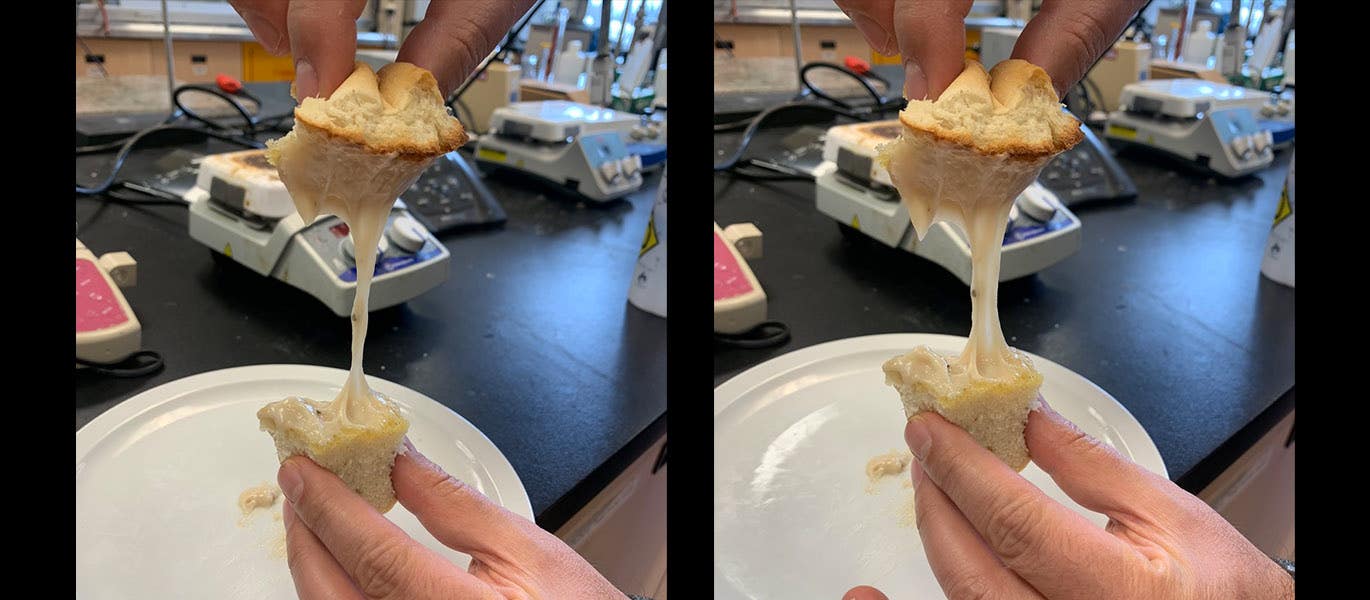Scientists perfect plant-based cheeses – stretch, melt, and taste like dairy
New study reveals how pea protein and blended fats can create plant-based cheese that mimics dairy in taste and texture.

The researchers are mixing and matching plant proteins with the goal of developing sustainable versions of cheeses that stretch and spread and melt just as dairy-based products do. (CREDIT: University of Guelph)
Plant-based cheese has become a popular choice for those who want to cut out dairy but still enjoy the taste and texture of traditional cheese. But making cheese from plants that stretches, melts, and tastes like dairy is no easy task. It takes a lot of science, experimentation, and testing to create something that looks and feels like the real thing. That’s what a group of researchers at the University of Guelph set out to do, and they’ve made impressive progress.
The Science Behind Plant Cheese
To mimic real cheese, scientists use ingredients that behave like dairy fat and protein. Many plant-based cheeses use coconut oil because it gives that rich, creamy texture people expect. But coconut oil also has high saturated fat, which isn't ideal for health. So researchers began testing blends that replace some of the coconut oil with healthier oils like sunflower oil.
They also tried out different plant proteins, which form the base of the cheese. These proteins act like scaffolding, holding the fat and other ingredients together. The team studied isolates from peas, lentils, and faba beans to see how they perform in cheese-like products. They found that not all proteins are equal. The way each protein interacts with fat and starch affects how the cheese melts, stretches, and holds its shape.
Alejandro Marangoni, one of the lead researchers, said, “If you wanted to strictly only eat plant-based products, you would end up eating a lot of beans and tofu, which can be a little bit boring after a while. Now, consumers expect essentially the same animal product but with plant-based ingredients, which is very difficult.”
Protein and Fat: A Powerful Duo
One of the key goals was to find a combination of protein and fat that could give plant cheese the right firmness and functionality. The researchers already knew that a blend of 25% coconut oil and 75% sunflower oil worked well when combined with a particular type of pea protein. That version of the cheese had high hardness, good melting ability, and a stretchy texture. These features are important for making plant cheese that performs well on pizza, in sandwiches, or as a snack.
In the new study, they tested three types of proteins: one from peas (called PP1), one from faba beans (FP1), and one from lentils. All were used at a concentration of 7.5% by weight. They checked the texture, stretch, melt, and oil loss of cheeses made with these proteins using both 25% coconut oil and 100% coconut oil.
Their findings were surprising. Cheese made with pea protein and just 25% coconut oil had a texture strength of 80 Newtons—almost as firm as the 100 Newtons found in cheese made with 100% coconut oil. That means you don’t need as much coconut oil to get a firm texture. Even better, the pea protein version matched or beat the others in stretch, melt, and oil release.
Related Stories
Better Health Without Sacrificing Texture
Reducing the amount of coconut oil cuts down on saturated fat. Using sunflower oil helps make the cheese healthier without losing the smooth, rich feel that people expect from cheese. “Ultimately we want to improve the nutrition, increase the protein content, and lower the saturated fat content of cheese alternatives,” said Marangoni. “But keeping all the functionality in there, which includes the melt and the stretch of the ‘cheese,’ is very difficult.”
To measure how the cheeses performed under heat, the team used complex tools. They tested properties like viscosity and elasticity at different temperatures, especially near 95°C (203°F)—close to the heat levels used in cooking. These tests helped them understand how each protein behaves when heated, which is important for cooking and food manufacturing.
The results showed that some proteins form better bonds with fat and starch, creating a more stable and functional cheese. The pea protein combined with the oil blend gave the best results in terms of both texture and performance. That means this version not only tastes and feels more like dairy cheese, but it also offers better health and sustainability benefits.
A Step Toward Greener Choices
Making cheese from plants has many benefits. It uses fewer natural resources than dairy farming. It also produces fewer greenhouse gases, making it a more environmentally friendly choice. Plus, using a mix of oils and plant proteins can help people reduce their intake of saturated fats while still enjoying tasty, melty cheese.
Still, creating a plant-based cheese that satisfies consumers is a big challenge. As Marangoni pointed out, “The behavior of milk proteins and meat proteins is reasonably well understood, but knowledge about the functionality of plant proteins is lacking. There is also a huge variety of different plant proteins, each one very different from one another.”
This new research adds valuable information to what scientists already know. It helps food makers design better, healthier plant-based cheeses without giving up the flavor and feel that people love.
Thanks to studies like this, the future of cheese could look very different. Instead of high-fat, high-impact dairy products, we may soon enjoy rich, stretchy plant-based cheeses that are better for us and for the planet.
What’s Next?
The next steps in this research will likely involve testing new types of plant proteins and refining the oil blends even more. Scientists may also look into how plant-based cheeses behave in different recipes and food applications. As this field grows, expect to see more plant-based options in stores that taste and feel even closer to the dairy originals.
For now, this work shows that with the right blend of science and ingredients, plant-based cheese can be both delicious and nutritious. It’s a win for your taste buds, your health, and the Earth.
Note: The article above provided above by The Brighter Side of News.
Like these kind of feel good stories? Get The Brighter Side of News' newsletter.
Mac Oliveau
Science & Technology Writer
Mac Oliveau is a Los Angeles–based science and technology journalist for The Brighter Side of News, an online publication focused on uplifting, transformative stories from around the globe. Passionate about spotlighting groundbreaking discoveries and innovations, Mac covers a broad spectrum of topics—from medical breakthroughs and artificial intelligence to green tech and archeology. With a talent for making complex science clear and compelling, they connect readers to the advancements shaping a brighter, more hopeful future.



